I'm very happy with Nemophila menziesii growing under Verbena lilacina. The camera doesn't know what to focus on, so the pictures are blurry. Better to enjoy them small.
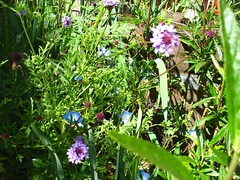
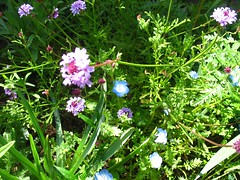
The camera has a hard time focusing on Phacelia campanularia too--I suspect because of the color. Most pictures I take of it do not turn out well.

Sometimes that's okay.
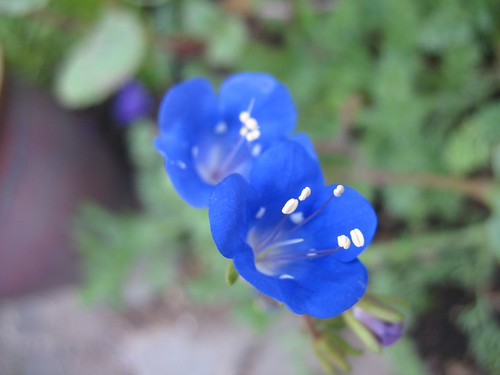
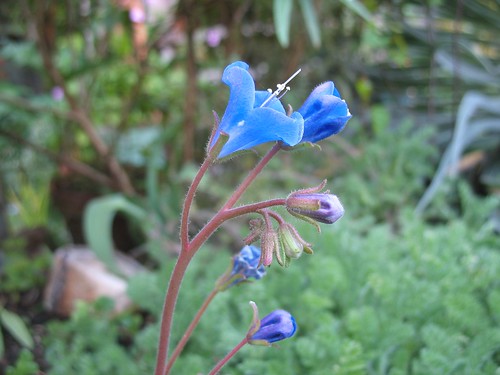
The Heracleum lanatum flower is opening about six feet up. This is eye-level for me.
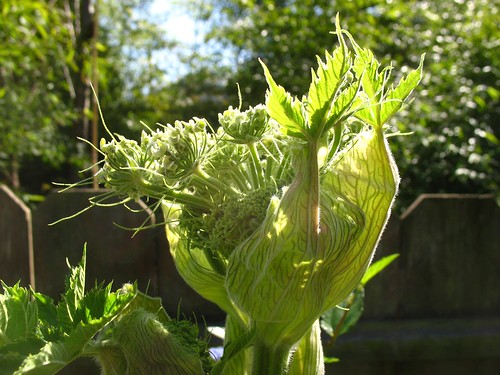
It looks a little less otherworldly from above.

At first I thought this was Watsonia foliage, but these are Camassia flowers, aren't they?
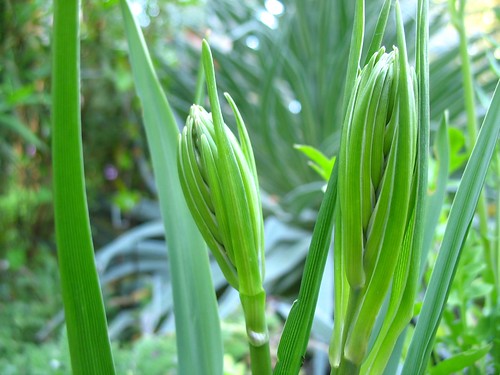
I planted C. quamash and C. leichtlinii bulbs all over. I can no longer recall exactly where. I have just a few Watsonia.
Three different things that look kind of similar: Echium wildpretii, Lupinus albifrons, Lilium sp.
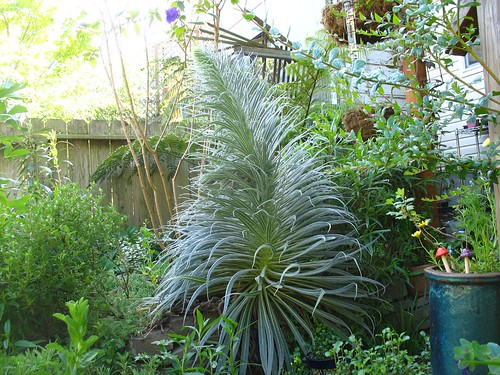
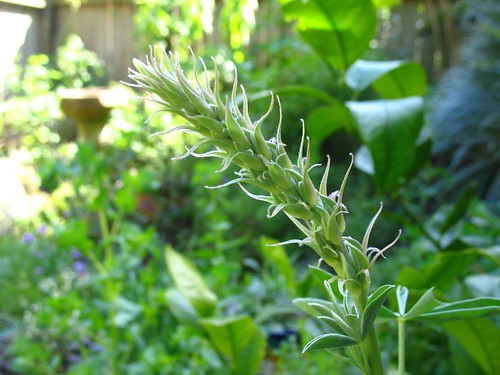
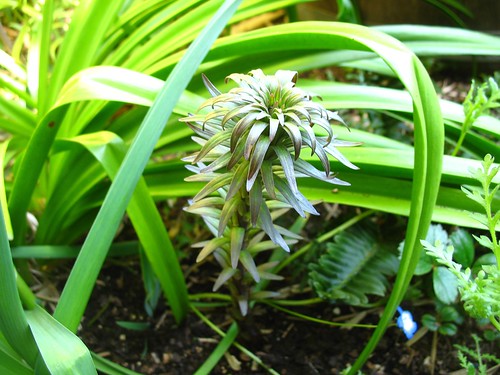
Some of the tulips opened pink.
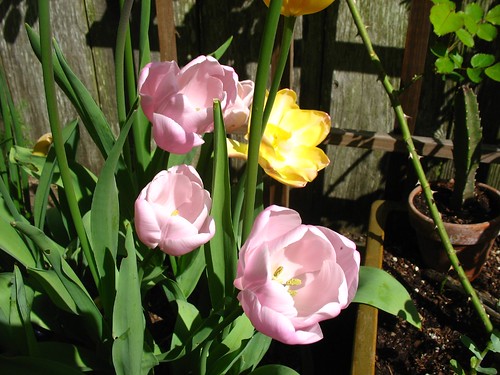
I can't stand to see the yellow ones juxtaposed with the Ceanothus flowers. It's just a bad color combination. Reminds me of Cal Berkeley school colors.
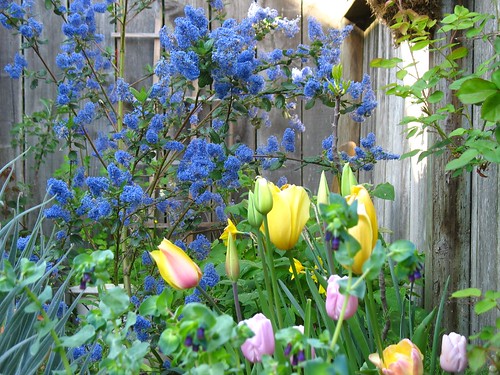
I think I would hate it less if the Ceanothus flowers were a little darker, or even more purple.
Speaking of purple...the Cobaea scandens flowers start out yellow-white, then turn dark purple.

The flower's decline begins with a complete collapse of the sex parts.
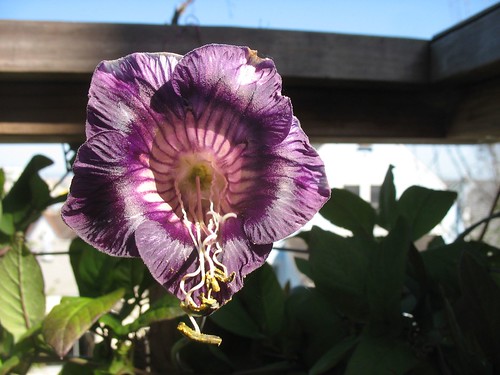
Every year I say I'm going to stop growing sweet peas (too much visual chaos), but I keep growing them.
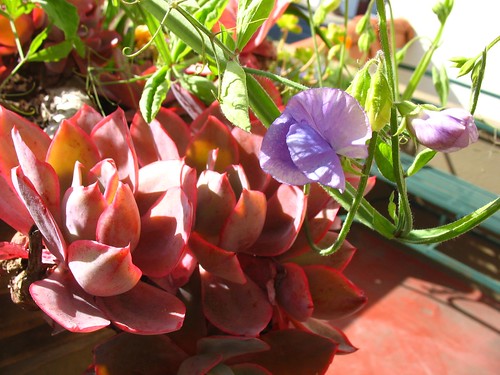
Can't decide which picture to use.

Cerinthe major. People call it Cerinthe major 'Purpurascens' even though it's always grown from seed. I'm a little confused about when it's "okay" to grow cultivars from seed. Supposedly cultivars are only propagated vegetatively..?
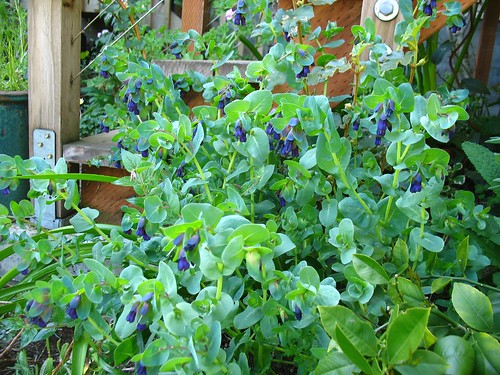
Speaking of growing things from seed, I have all these plants I need to do something with. Like, soon.
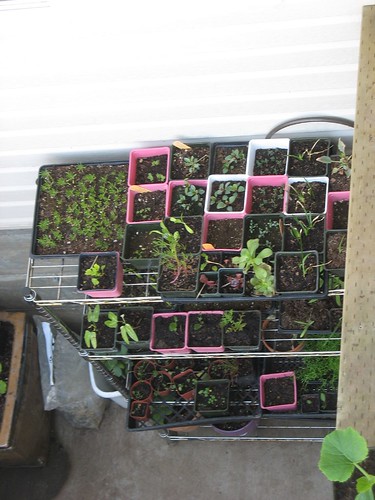
These Penstemon palmeri started off slow, but now I have dozens of strapping seedlings.
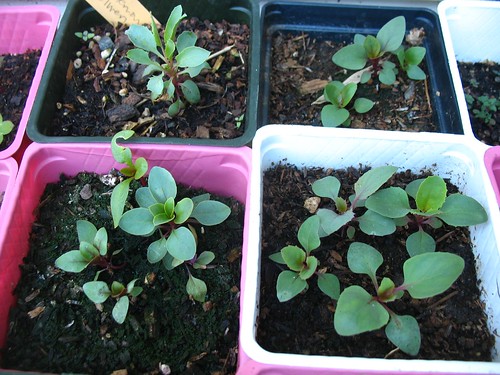
Did you see the article about penstemon in the new issue of Garden Design? This species is mentioned. It has three special features: the inflorescence is uncommonly tall for penstemon (five feet), the flowers are fragrant (penstemon is mostly scentless), and, accustomed to desert conditions, it's very drought tolerant (more than 10 inches of water a year will kill it).
I have it growing next to Delphinium cardinale (five feet tall inflorescences of red flowers), and Symphyotrichum chilensis (formerly Aster chilensis, four feet tall sprays of blue, aster-type flowers). My summer garden will have some serious vertical interest this year.
I decided to sow a whole second flat of Gilia tricolor.
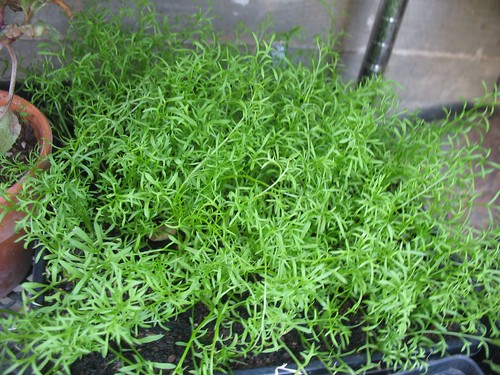
And I started again with Linanthus. Slugs devastated the first round.
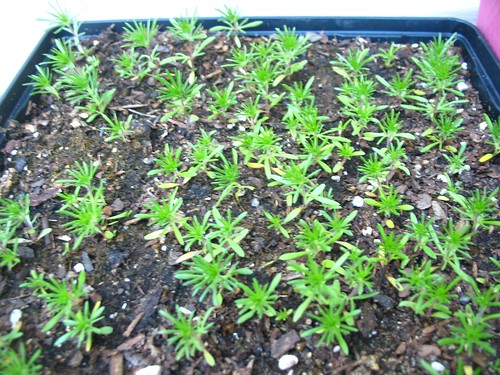
I still have some Madia elegans to plant. I'm not sure how many I've already planted. I can only find a few in the garden.

I'm a little late with vegetables this year. I just planted out some tomatoes and squash yesterday. Last year, I had everything in place by March 15. Everyone was selling the Mexican Sour Gherkin seeds this year (Melothria scabra)--does everyone sell it every year? I thought the fruit looked cute in pictures. I'm a little apprehensive about the taste. 75% germination.

I've been thinking that I might have enough annuals in my garden this year; this South African Heliophila coronopifolia might work better at my client's house. I planted a South African bed in her front yard, including Chondropetalum tectorum, Psoralea pinnata, Pelargonium tomentosum, a yellow-flowering leucadendron, and I allowed a hebe that was already there to remain. The heliophila's little blue flowers might be a nice addition.
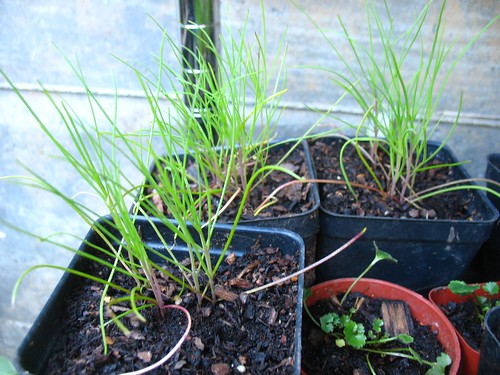
I've been trying to think of what to replace this year's foxglove with after it dies. I have several huckleberry seedlings that will enjoy the same shady conditions, but they're very small and will be small for a few years. I decided to try Meconopsis betonicifolia (Himalayan Blue Poppy). Germination was easy. They should do well in San Francisco's cool-ish summers.
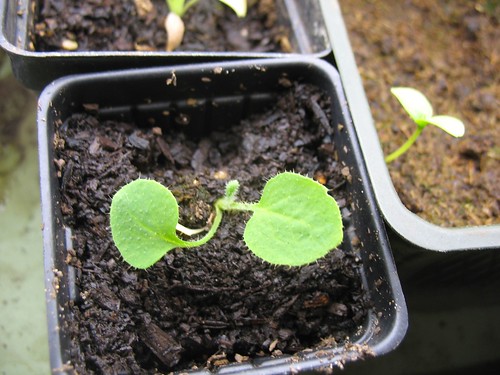
Meanwhile, the foxglove basal rosettes are getting huge.
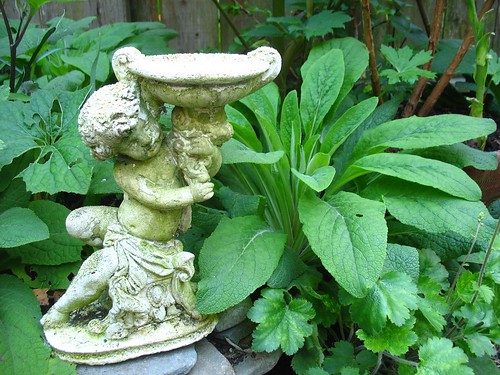
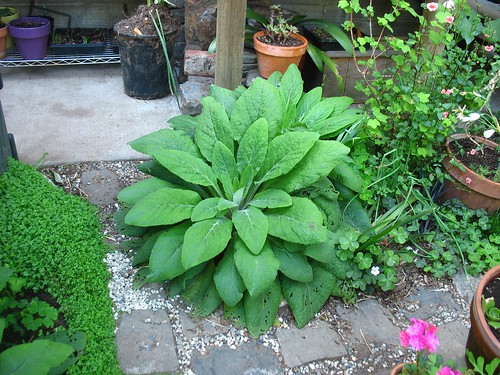

21 comments:
Glad you're back - and feeling better. The photos are great and I have serious seedling envy now. I have been a madwoman this winter putting wildflower seed (ummm, rather thickly) everywhere. But in this dry spell, I have been trying to keep them all happy as it warms here. Last year was a perfect year for wildflowers here and I have many reseeders. Wish it would rain a tiny bit more.
Yes, I would also very much like to have some April showers.
It is hard to imagine that my spindly little Digitalis seedlings have the possibility to turn into such lush plants. I plan to pot some of them up into bigger pots tomorrow so I can adequately fertilize them and plant their splindly root stems a bit deeper.
OMG, I hate the Cal colors too. That Ceanothus and Tulip combo is bad, but not as bad. Just pastel bad.
I'll be very interested to follow your progress with the Meconopsis -- I think Annie's is no longer selling it, but I don't know what that means. Also P. palmeri. If more than 10 inches is really going to kill it, how are you planning to keep it alive?
Your echium has gone wild!
Glad to see your garden looking so full of life. Your seedlings are strong, do you fertilize them now or wait until they go in the ground, or not at all? I wanted to ask you about the dierama, too. I have three or four leafy looking things in the same pot they were sown in, looking like skinny irises. When can they go in the ground, and where should they go? Can they be moved or do they dislike that? We still have frost possibiliies until mid April, so not until then will they are any of the seedlings go into the ground. Any ideas, oh guru of seedlings?
Frances
Frances, I do fertilize some seedlings sometimes--with half-strength Miracle Gro or half-strength fish emulsion. I never fertilize before the second pair of true leaves have emerged. Sometimes I don't do it at all. Whenever I feel in my gut that a seedling needs fertilizer, I do it, but just once or twice.
Re Dierma: you and I both are on new ground here! I started all mine in one four inch pot. I finally divided them just a week ago. I put 3-4 each in several more 4" pots with fresh container mix--that's actual planting mix, not the sterile peat. They need to get soil nutrients now. I plan to maintain them in successively larger pots until the roots look good and ready for planting out, even if that means waiting another year. In San Francisco, they want full sun, and regular water especially when young. It gets warmer where you are...they might grow faster.
Pam, It really has, especially that one. The other one seems more self-possessed. It grows, but seems less wild.
Alex, the penstemon will flower the first year. If it flowers once, and dies by next January, oh well. Who knows--it might live for two years, and then die. Also, my garden is densely planted, so maybe the soil dries out faster than the same soil in nature where competing roots are farther away. On the other hand, my soil is not sandy at all so that's a problem for P. palmeri too.
I think I'm going to snip the yellow tulips.
Christopher, I suspect your digitalis will take off with the first summer heat.
I don't hate the blue and yellow, though blue and orange, or purple and yellow, would be better.
Some bright green might tie the light blue and yellow together better.
That Cobaea scandens completely knocks me out--gorgeous. And no wonder you can't stop growing sweet peas, since they look so cool against those reddish succulents.
The blue and yellow don't bother me too much... not as much as that pink, as you can imagine! *grin*
Great shot of the heracleum (the otherworldy one). Someone told me you can get a skin rash from handling Heracleum, have you heard anything about this or experienced it yourself? Either way, it's a very cool plant. I recently read Piet Oudolf's Designing with Plants (finally) and I think he'd like Heracleum, since it's so bold and tall.
Your other verticals sound good too. I grew palmer's penstemon in Flagstaff (lot's of sun, excellent drainage) and I'm a big fan of CA's red delphiniums.
There are some deadly Heracleums. Must be careful with that genus.
I haven't heard anything bad about H. lanatum...and no rash from handling it here or at the Botanical Garden where I've had more exposure to it.
Kim, the cobaea flower is so big... It actually seemed kind of vulgar to me at first. Like obscene vulgar. But I'm getting used to it. I'll like it more when flowers cover the deck railing.
The digitalis (and EVEYTHING) looks great. It seems to me that digitalis don't really "take off" until they are in the ground. I've looked at their roots and believe that they must be sent down quite deep before the plant really "commits" (if you know I mean). They do ok going from seedling cup to pot to larger pot... but put 'em in the ground when the soil is warm and they just go mad.
Like yours.
I've had to edit out a few and I was surprised by the extent of the root system, which is very fibrous.
"The flower's decline begins with a complete collapse of the sex parts."
As for us all.
Am I the only one who likes the blue and yellow together, Chuck? I didn't know the California Berkeley school colors - had to look them up and find out about the Yale Blue and California Gold.
Dark grayed-blue with gold doesn't seem that close to the gorgeous Ceanothus and the yellow tulips.
With no tulips here I don't even mind the pink ones.
Is 4606 an orchid?
It's been dry here, too - wildflowers not doing much except where irrigated.
Annie at the Transplantable Rose
Well, it reminds me of the Cal blue and gold. Which btw were also my high school colors--probably the real reason I don't like them together.
4606 is an orchid family plant. It's called Pleione formosana. Sorry I didn't label it. Or anything else! BAD.
What a riot of color! Thanks for showing the flowering progression of the Cobaea...very cool.
I'm glad you got the blue himalayan going. How's it coming along?
Rick Lucha, Forestgreen2@comcast.net
Post a Comment